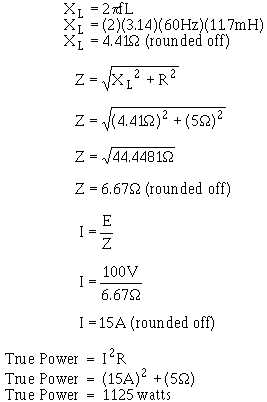3-45
Now, if the value of inductance is decreased to 11.7 millihenries, the formulas yield the following
values:
So a decrease in inductance of 11.3 millihenries (23 mH—11.7 mH) causes an increase in power to
the load (true power) of 625 watts (1125 W—500 W). If it took 1 watt of power to change the inductance
by 11.3 millihenries (by some electrical or mechanical means), figure 3-29 would represent a power
amplifier with a gain of 625.
Q-39.
What is the frequency classification of a magnetic amplifier?
Q-40.
What is the basic principle of a magnetic amplifier?
Q-41.
If inductance increases in a series LR circuit, what happens to true power?
METHODS OF CHANGING INDUCTANCE
Since changing the inductance of a coil enables the control of power to a load, what methods are
available to change the inductance? Before answering that question, you should recall a few things about
magnetism and inductors from NEETS, Module 1—Introduction to Matter, Energy, and Direct Current,
chapter 1—Matter, Energy, and Electricity; and Module 2 —Introduction to Alternating Current and
Transformers, chapter 2—Inductance.
Permeability was defined as the measure of the ability of a material to act as a path for additional
magnetic lines of force. Soft iron was presented as having high permeability compared with air. In fact,
the permeability of unmagnetized iron is 5000 while air has a permeability of 1. A nonmagnetized piece
of iron has high permeability because the tiny molecular magnets (Weber's Theory) or the directions of
electron spin (Domain Theory) are able to be aligned by a magnetic field. As they align, they act as a path
for the magnetic lines of force.

